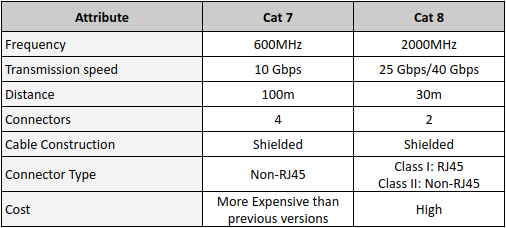
Supposedly, you have to install data cables for your newly built house. But don’t have any clue about them. And we all know that it can get overwhelming with the variety of ethernet cables available in the market such as Cat5, Cat5e, Cat6, Cat6a, Cat7, cat8, and so on.
So, if you are selecting the cable for your place then it is important to understand their features and capabilities.
Presently, Cat 7 and Cat 8 cables are marking their presence in the market with their efficiency and compatibilities with other ports. And complicated questions are bound to arise like if using Cat 8 with standard Cat 7 would work or not.
To answer such questions before they arise, let’s understand Cat 7 and Cat 8 in details including their main differentiating point.
General Information:
Cat 7 Cables:
Category 7 cable known as a Cat7 or Cat-7 cable is used to cable the infrastructure of Gigabit Ethernet. It offers up to 600MHz. A perfect choice to cable your smart home. After cabling, you can even check for the automation ideas. It supports high-speed ethernet communication up to 10 Gbps. These are backward compatible with Cat6, Cat5, and Cat5e categories. It provides a 100-meter 4-connector channel with shielded cabling. They require twisted wires to become a full shield system. Such systems are known as screen shielded twisted pair (SSTP) or screened foiled twisted pair (SFTP) wiring. It eliminates alien cross talk with improved noise resistance. It allows users to get higher speeds with longer cables.
Cat 8 Cables:
Category 8, Cat8 cable or Cat-8 cable is an ethernet cable which is a different type of cable standing apart from the previous cables. It supports a frequency of up to 2GHz(2000 MHz). It is limited up to the 30-meter 2-connector channel. It requires shielded cabling as well. The major point to consider is that it can support a speed of 35 Gbps or 40 Gbps. Overall, its physical appearance is similar to lower category cables. They terminate in RJ45 connections or non-RJ45 connections. It is compatible with all its backward versions. You can use it with the standard connectors of previous versions such as Cat-7.

Cat 7 vs Cat 8 Comparison
While comparing these cables transmission frequency and cabling length are of great importance. Here is the detailed comparison:
Performance:
Cat7 cable offers performance up to 600 MHz Whereas Cat8 offers up to 2000 MHz
Cabling Length:
The maximum cabling length of Cat 7 network is 100m with 10 Gbps. Whereas Cat8 is limited to 30m cabling length with 25 Gbps or 40 Gbps.
Pricing:
If we consider pricing, Cat 8 cables are more expensive than other standards considering its unique features.
Shielding:
Both the cables have shielding cable construction. Cat 7 cable offers extensive shielding for reduced attenuation. And they require special GigaGate45 connectors to attain the full advantage of its higher performance features.
As Category 7 cables offer 1 100-meter 4-connector channel with shielded cabling, even if it operates at a higher frequency, there would be no improvement in data rate. Because 10GBase-T is still the fastest twisted pair-based data rate recognized by IEEE 802.3. Hence, even if a Category 7 cabling system is there in your network, any available active equipment would have limitations up to 10-Gbit/sec performance. It is not a recognized category by TIA.
Category 8 cables require shielded cabling. Unlike Cat5e to Cat6A, it does not come with an unshielded twisted pair. The most likely cable construction for Category 8 will be 22-AWG S/FTP cabling.
Features Summary:

Pros and Cons:
Cat 7 Cables:
- Pros : Shielded with a higher operating frequency than Cat6a cables.
- Cons : They are a bit expensive. They require 40 to 60% more space to contain the cable and different connections. Their testing is trickier and requires modern test equipment. There is no real speed advantage over a good Cat6a system.
Cat 8 Cables:
- Pros : The fastest copper network is available for any distance.
- Cons : Due to different connectors, they are not compatible with cat5e and cat 6 cables. These cables are expensive than the previous versions.
Pick Your Choice!
These ethernet cables are modern-day products designed to cable appropriate environments. Based on the feature comparison, you can pick your choice to make a that fits your requirement and helps you render maximum data speed.
Still confused which cable to pick? Post your query in the comment section below and we’ll try our best to help you out.
